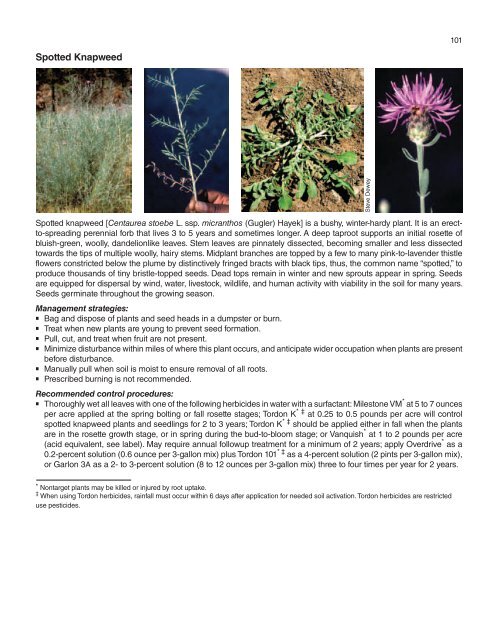A Management Guide for Invasive Plants in Southern Forests James ...
A Management Guide for Invasive Plants in Southern Forests James ...
A Management Guide for Invasive Plants in Southern Forests James ...
- No tags were found...
You also want an ePaper? Increase the reach of your titles
YUMPU automatically turns print PDFs into web optimized ePapers that Google loves.
101Spotted KnapweedSteve DeweySpotted knapweed [Centaurea stoebe L. ssp. micranthos (Gugler) Hayek] is a bushy, w<strong>in</strong>ter-hardy plant. It is an erectto-spread<strong>in</strong>gperennial <strong>for</strong>b that lives 3 to 5 years and sometimes longer. A deep taproot supports an <strong>in</strong>itial rosette ofbluish-green, woolly, dandelionlike leaves. Stem leaves are p<strong>in</strong>nately dissected, becom<strong>in</strong>g smaller and less dissectedtowards the tips of multiple woolly, hairy stems. Midplant branches are topped by a few to many p<strong>in</strong>k-to-lavender thistleflowers constricted below the plume by dist<strong>in</strong>ctively fr<strong>in</strong>ged bracts with black tips, thus, the common name “spotted,” toproduce thousands of t<strong>in</strong>y bristle-topped seeds. Dead tops rema<strong>in</strong> <strong>in</strong> w<strong>in</strong>ter and new sprouts appear <strong>in</strong> spr<strong>in</strong>g. Seedsare equipped <strong>for</strong> dispersal by w<strong>in</strong>d, water, livestock, wildlife, and human activity with viability <strong>in</strong> the soil <strong>for</strong> many years.Seeds germ<strong>in</strong>ate throughout the grow<strong>in</strong>g season.<strong>Management</strong> strategies:Bag and dispose of plants and seed heads <strong>in</strong> a dumpster or burn.Treat when new plants are young to prevent seed <strong>for</strong>mation.Pull, cut, and treat when fruit are not present.M<strong>in</strong>imize disturbance with<strong>in</strong> miles of where this plant occurs, and anticipate wider occupation when plants are presentbe<strong>for</strong>e disturbance.Manually pull when soil is moist to ensure removal of all roots.Prescribed burn<strong>in</strong>g is not recommended.Recommended control procedures:Thoroughly wet all leaves with one of the follow<strong>in</strong>g herbicides <strong>in</strong> water with a surfactant: Milestone VM * at 5 to 7 ouncesper acre applied at the spr<strong>in</strong>g bolt<strong>in</strong>g or fall rosette stages; Tordon K * ‡ at 0.25 to 0.5 pounds per acre will controlspotted knapweed plants and seedl<strong>in</strong>gs <strong>for</strong> 2 to 3 years; Tordon K * ‡ should be applied either <strong>in</strong> fall when the plantsare <strong>in</strong> the rosette growth stage, or <strong>in</strong> spr<strong>in</strong>g dur<strong>in</strong>g the bud-to-bloom stage; or Vanquish * at 1 to 2 pounds per acre(acid equivalent, see label). May require annual followup treatment <strong>for</strong> a m<strong>in</strong>imum of 2 years; apply Overdrive * as a0.2-percent solution (0.6 ounce per 3-gallon mix) plus Tordon 101 * ‡ as a 4-percent solution (2 p<strong>in</strong>ts per 3-gallon mix),or Garlon 3A as a 2- to 3-percent solution (8 to 12 ounces per 3-gallon mix) three to four times per year <strong>for</strong> 2 years.* Nontarget plants may be killed or <strong>in</strong>jured by root uptake.‡ When us<strong>in</strong>g Tordon herbicides, ra<strong>in</strong>fall must occur with<strong>in</strong> 6 days after application <strong>for</strong> needed soil activation. Tordon herbicides are restricteduse pesticides.
















